
The de Havilland Gipsy Major or Gipsy IIIA is a four-cylinder, air-cooled, inverted inline engine used in a variety of light aircraft produced in the 1930s, including the famous Tiger Moth biplane. Many Gipsy Major engines still power vintage aircraft types worldwide today.
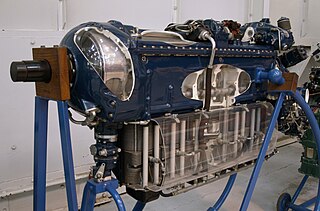
The de Havilland Gipsy Queen is a British six-cylinder aero engine of 9.2 litres (560 cu in) capacity that was developed in 1936 by the de Havilland Engine Company. It was developed from the de Havilland Gipsy Six for military aircraft use. Produced between 1936 and 1950 Gipsy Queen engines still power vintage de Havilland aircraft types today.
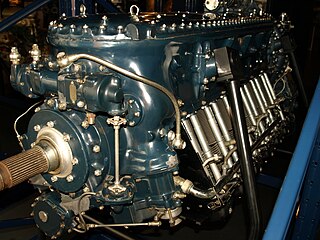
The de Havilland Gipsy Twelve was a British aero engine developed by the de Havilland Engine Company in 1937. Approximately 95 were manufactured. It was known as the Gipsy King in Royal Air Force service.

The Potez 4D was a four-cylinder, inverted inline aircraft engine. It was first built shortly before World War II, but did not enter full production until 1949. Like the other D-series engines, the cylinders had a bore of 125 mm (4.9 in) and a stroke of 120 mm (4.7 in). Power for different models was in the 100 kW-190 kW (140 hp-260 hp) range.

The de Havilland Gipsy is a British air-cooled four-cylinder in-line aircraft engine designed by Frank Halford in 1927 to replace the ADC Cirrus in the de Havilland DH.60 Moth light biplane. Initially developed as an upright 5 litre capacity engine, later versions were designed to run inverted with increased capacity and power.

The de Havilland Gipsy Six is a British six-cylinder, air-cooled, inverted inline piston engine developed for aircraft use in the 1930s. It was based on the cylinders of the four-cylinder Gipsy Major and went on to spawn a whole series of similar aero engines that were still in common use until the 1980s.

The Walter Mikron is a four-cylinder, air-cooled, inverted straight engine for aircraft.

The Alfa Romeo 115 was an Italian 6-cylinder air-cooled inverted inline engine for aircraft use, mainly for training and light planes, based on the de Havilland Gipsy Six engine. Production totalled approximately 1,600 units. Derivatives of the 115 include the -1, bis, ter and Alfa Romeo 116.

The Alfa Romeo 110 was an Italian four cylinder air-cooled inverted inline engine for aircraft use, mainly for trainers and light aircraft. The Alfa Romeo 110 was based on the de Havilland Gipsy Major, with approximately 500 units produced. Derivatives of the 110 include the -1, ter and Alfa Romeo 111.

The Walter Minor is a family of four- and six-cylinder inverted inline air-cooled engines, developed under auspices of ing. Šimůnek and used on light aircraft. First produced in 1929, the Minor engines' family has an advanced design for the period and sports steel cylinders, aluminum heads and overhead valves, with identical bore and stroke of 105 mm (4.1 in) and 115 mm (4.5 in), respectively. Typical power ratings varied from 105 hp to 160 hp.

The Blackburn Cirrus Major is a British, inline-four aircraft engine that was developed in the late 1930s.

The de Havilland Gipsy Minor or Gipsy Junior was a British four-cylinder, air-cooled, inline engine used primarily in the de Havilland Moth Minor monoplane, both products being developed in the late 1930s.

The Napier Javelin was a British six-cylinder inline air-cooled engine designed by Frank Halford and built by D. Napier & Son. First flown in March 1934 in the prototype of the Percival Mew Gull racing aircraft, the engine was also used in the Spartan Arrow biplane and the Percival Gull.
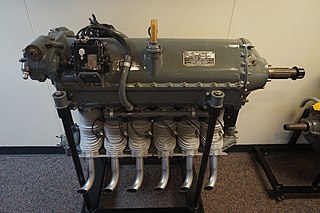
The Ranger L-440 are six-cylinder inline inverted air-cooled aero-engines produced by the Ranger Aircraft Engine Division of the Fairchild Engine and Airplane Corporation of Farmingdale, New York, United States. The engine was mainly produced for Fairchild's family of training aircraft in the mid-1930s.
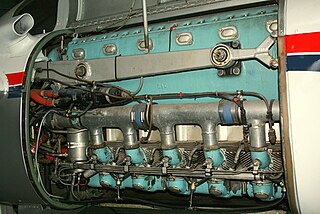
The Avia M 337 is an inverted six-cylinder air-cooled inline engine. It was developed by the Czechoslovak company as a six-cylinder derivative of the four-cylinder M 332 engine, going into production in 1960. An unsupercharged version of the M 337 is designated as the LOM M137. Production transferred to Avia in 1964, and to Letecke Opravny Malesice (LOM) in 1992.

The Blackburn Cirrus Bombardier was a British four-cylinder inline aircraft engine, developed and built by the Blackburn Aircraft company in the mid-1950s. The engine featured fuel injection.
The Blackburn Cirrus Midget was a British four-cylinder, inverted, inline air-cooled aero engine designed and built in 1937 by the Cirrus Engine Section of Blackburn Aircraft Limited. Little is known of its development and use, its sole aircraft application being reported as the Chilton D.W.1 although it is possible that this did not transpire.
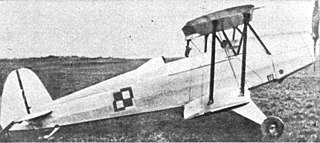
The PWS-35 Ogar was a two-seat, aerobatic training biplane that was designed by Kazimierz Nowicki, Marian Piątka and Michał Rosnowski at the Lviv Polytechnic in 1935/1936.

The Walter Junior was a family of four cylinder air cooled horizontally-opposed engines produced by Walter Aircraft Engines in Czechoslovakia in the 1930s for aircraft, characterised by a bore and stroke of 115 mm × 140 mm, a displacement of 5,814 cm3 (354.8 cu in) and producing roughly 78 kW (105 hp).
The Alfa Romeo 122 was a 12-cylinder inverted-V aircraft engine produced in 1941 by Alfa Romeo Milano as a licence-built Czechoslovakian Walter Sagitta, featuring a single-speed supercharger. The 122 R.C.38 major production variant had a reduction gearbox, single stage super-charger and rated altitude of 3,800 m (12,500 ft).



















